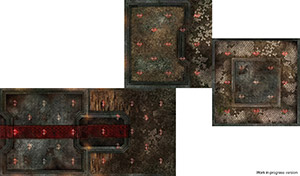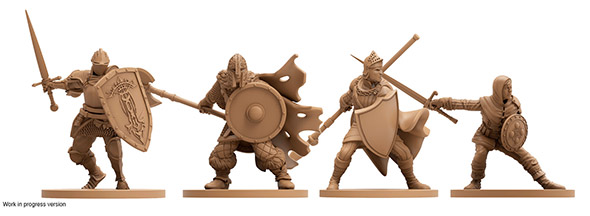by Luna Lee
Standing to the left of the Dancer of the Boreal Valley, the Herald pauses, after a flurry of attacks, to take stock of the situation: with two stamina/health points left available to him and the Dancer at two health, he can expend one last stamina point try to make a final blow to end it all, or use it to run to safety and recuperate before re-engaging. He decides to attack. After marking his stamina point usage, and thus leaving himself with only one health, the Herald gathers up one red and one blue die and makes the roll: two zeros. In one fell swoop, the Dancer swings around to face him and slashes for three damage. Reactively, the Herald attempts to mitigate the incoming damage with his strength, but feebly rolls a one. It is not enough. He falls, and returns to his bonfire to try again...
Known for its brutal difficulty, Dark Souls has captured the zeal of many enthusiasts, including us at RPGFan. Thus, when we heard that Steamforged Games' Kickstarter for a Dark Souls: The Board Game far surpassed its initial goal of £50,000 to reach over £3,500,000, we knew we had to check it out. With an intricate battle system that rewards careful balance of offense and defense, we were curious to see how these mechanics would carry over to the board game.

At Origins 2016, Bob and I spent some time chatting with Mat Hart, Creative Director of Steamforged Games, and DC, Lead Designer, to find out more about the board game and how it compares to the its video-based uncle. With more than 15 years of experience in the video game industry, Mat pitched the idea of the Dark Souls: The Board Game to Bandai Namco, who loved the concept and granted them the license. Fast forward time and here we are with a fully funded Kickstarter and numerous stretch goals reached. For those who missed the Kickstarter, fret not, as Steamforged Games still has a late pledge system available to acquire a copy of the game and all reached stretch goals for £80 (approximately $118 as of publication) here. Dark Souls is slated for released in April 2017.

At its core, Dark Souls is a 1-4 player cooperative game that emulates the exploration experience in the video game and culminates in a final boss fight for each playthrough. Players choose one of the many available classes from the video game. The base set includes the Knight, Warrior, Herald, and Assassin; and the achieved stretch goals add the Pyromancer, Cleric, Sorcerer, Thief, Mercenary, and Deprived. Each class has its own unique abilities and stats that contribute to the fights in various ways.

Teams and brave soloists begin a playthrough at a bonfire. As they move around and explore, new board tiles are revealed and randomized encounter cards are drawn. Initially, players are seeking a chosen mini boss. After defeating the mini boss, a different encounter deck is drawn for locating the final boss. All mini bosses and main bosses feature a randomized card sequence that determine their movements and attacks and, for the most part, retain their order therefore rewarding players who pay attention to patterns. While exploring, each discovered gravestone enables players to peek at one of the five boss attack cards, further giving them an opportunity to strategize in advance.
Players can always return to the bonfire to save their progress by expending a charge. Should they die in the midst of wandering, they will respawn at the bonfire, but lose a charge. Since bonfire charges are limited, players must balance between saves and leaving enough in reserve for failure. Once all charges in the bonfire are extinguished, the game is lost.

Combat progresses fluidly in a manner that captures the essence of the video game: juggling resources while attacking. Characters have a stamina-health system that exists on a continuum; stamina decreases from the left, and health from the right. Should the reduction of both meet at any point on the continuum, the player will die. Stamina is expended to take actions, such as moving one space, attacking, blocking, dodging, using a potion to heal damage, and resting to regain all stamina. Concurrently, health is diminished when the character takes a blow. Damage dealt to a player can either be partially or fully mitigated by rolling strength, or completely dodged by rolling agility to match the incoming damage. Thus, players need to dance between aggression and pulling back to recuperate stamina for actions, while also considering the enemy's next attack pattern to ensure safety. Though details are not revealed for now, the developers promise equipment, spells, unique abilities, invaders, and summons that will further enhance and complicate combat.
For more information regarding exploration and boss combat, you can view the videos below:
Exploration
Boss Fight
As we stood by the demo table watching two players duke it out with the Dancer, many others weaved in and out of the booth with some staying to watch the action unfold. Swiftly, the Warrior succumbs to overexerting and unlucky positioning, leaving the Herald to ardently fight by himself. The palpable tension of the crowd weighs heavily. With careful footwork and timely recuperation, the Herald soon takes the Dancer down to half health: 20 hit points.

At this moment, the special boss card is revealed with a flourish and the boss deck completely reshuffled, thus upending the prior patterns. Still, the congregation cheers the Herald on as he proceeds to further whittle down the Dancer. Finally, he catches a vulnerable side at full stamina and starts slashing frantically — one, two, three, four, five stamina used. With bated breath, the crowd bubbles in excitement as the Herald chips away — 12, 9, 7, 5, 2 hit points. Giddy with success, he rolls for one last final attack in a less than advantageous position — and misses; a low "ooh" erupts in waves from the onlookers. The Dancer spins around and sinks its blades into the Herald, who fails to block, and the fight is over.
If anything, the game looks absolutely breathtaking. The miniatures, in particular, are intricately detailed and the components reflect the overall vibe of the Dark Souls universe. Similar to the video game, the boss miniatures tower over the characters intimidatingly. As the boss turns and lunges towards the characters I almost feel a shiver go up my spine imagining what it would be like to stand there. For the price of £80, the quantity and quality of the components more than surpasses expectations. Players who enjoy painting miniatures will find much room for enhancing the grotesqueness and creep factor of the enemies.

Certainly, the board game can't fully replicate the video game experience given that they are completely separate mediums. However, the developers have keenly captured the feeling of Dark Souls: the exploration, gathering of clues and patterns, and resource management and attacks in fights. Even though combat may seem on the light side, it's clear that players who do not take the game seriously can easily end up paying with their lives, and what could be more exact an adaptation of the original series?
As Mat espoused, the development team has a good mix of individuals with board game and Dark Souls experience, which creates an excellent support system for incorporating key aspects of the video game into board game mechanics. While it's impossible to translate one medium completely to another, Steamforged Games have managed to pinpoint the draw of Dark Souls and wrestle it into a fluid, tactical, and turn-based game.
Given the quick set-up and straightforward rules, fans of the video game series may find this to be an entry portal into the wonderful whirlpool of ever-growing board games. On the flip side, board gamers like me who once vicariously lived through Let's Play videos due to hopelessly uncoordinated digits can finally lumber into the Dark Souls universe without tripping. Quality crossovers between video games and board games are starting to gain traction in both industries and I certainly hope there is much more to come from both Steamforged Games and many others.